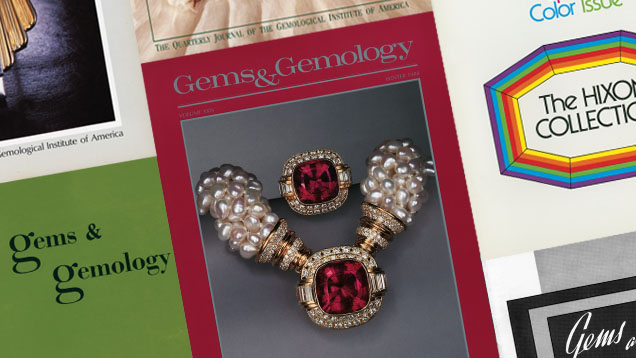Landmark Articles from
Gems & Gemology
April 14, 2014

We asked the magazine’s editor and key contributors to review the journal’s body of work, and select articles they considered to be especially significant. After reviewing this treasure trove of materials, they picked ones that were particularly important to advancing gemological knowledge and providing practical insights to the gem and jewelry industry.
We share with you their selections.
A Solution to Diamond Color Grading Problems
By Robert M. Shipley and R.T. Liddicoat
FALL 1941, VOL. 3, NO. 11, PAGES 162-167
Robert Shipley Sr. and Richard Liddicoat describe methods for evaluating the color of colorless to light-yellow diamonds by the use of a standardized light source for viewing; and a prototype colorimeter for grading the color against a graduated color scale (which would later become the D-to-Z color grade scale).
The GIA diamond grading system was introduced in the early 1950s, with the first diamond grading reports issued in 1955. It is now the international standard for evaluating diamond quality.
New or Unusual Gem Materials Encountered in the Institute’s Gem Trade Laboratories
By G. Robert Crowningshield
SUMMER 1957, VOL. 9, NO. 2, PAGES 35-37, 61-62
Robert Crowningshield’s debut column describes new and interesting gem materials submitted to GIA for examination. Nearly 60 years later, reports on gem materials still appear in the “Lab Notes” section of the journal.
An Introduction to Spectroscopy in Gem Testing
By G. Robert Crowningshield
SUMMER 1957, VOL. 9, NO. 2, PAGES 46-55, 62
In the early 1950s, GIA lab staff used a spectroscope pioneered in the United Kingdom to identify diamonds and colored gemstones. During the next few years, Robert Crowningshield became one of the masters in using the spectroscope for studying gems, and also created hand-drawn patterns of spectral bands of a wide variety of gem materials.
Here Crowningshield describes how gemologists can use the spectroscope. Reproductions of a number of his spectra drawings are included. The spectroscope remains one of the most important instruments for gem testing.
Developing the Powers of Observation in Gem Testing
By R.T. Liddicoat
SUMMER 1962, VOL.10, NO. 10, PAGES 291-303
Richard Liddicoat describes methods for observing key features in gem material to determine their identity. More than 50 years later, these methods remain an essential component of GIA gem identification courses.
Rapid Sight Estimates of Diamond Cutting Quality
By R.T. Liddicoat
FALL 1962, VOL. 10, NO. 11, PAGES 323-335
The face-up appearance of a diamond depends upon the proportions of the facets and their related angles. Richard Liddicoat describes visual techniques that allow gemologists to estimate important proportion values.
The Characteristics and Identification of Filled Diamonds
By John I. Koivula, Robert C. Kammering, Emmanual Fritsch, C.W. Fryer, David Hargett, and Robert E. Kane
SUMMER 1989, VOL. 25, NO. 2, PAGES 68-83
Filling surface-reaching breaks with a special glass can hide clarity characteristics and improve the apparent clarity of a diamond. This is the most widespread treatment used on colorless and near-colorless diamonds. The authors describe the visual clues gemologists can use to recognize clarity-treated diamonds.
Color Grading of Colored Diamonds in the GIA Gem Trade Laboratory
By John M. King, Thomas M. Moses, James E. Shigley, and Yan Liu
WINTER 1994, VOL. 30, NO. 4, PAGES 220-242
Colored diamonds are the most valuable and some of the rarest gem materials in the marketplace. The procedures used by GIA to observe and describe the color of these diamonds, and the addition of “Fancy grade” terms are detailed here.
Beryllium Diffusion of Ruby and Sapphire
By John L. Emmett, Kenneth Scarratt, Shane F. McClure, Thomas M. Moses, Troy R. Douthit, Richard Hughes, Steven Novak, James E. Shigley, Wuyi Wang, Owen Bordelon, and Robert E. Kane
SUMMER 2003, VOL 39, NO. 2, PAGES 84-135
Heating is the most widely used treatment to change the color or appearance of ruby and sapphire. This process is often augmented by the diffusion of certain elements into corundum to produce a surface-related color zonation. John Emmett and others describe the various mechanisms used to create or modify color in corundum by heating and diffusion treatments.
A Foundation for Grading the Overall Cut Quality of Round Brilliant Cut Diamonds
By Thomas M. Moses, Mary L. Johnson, Barak Green, Troy Blodgett, Kim Cino, Ron H. Guerts, Al M. Gilbertson, T. Scott Hemphill, John M. King, Lisa Komylak, Renee M. Renitz, and James E. Shipley
FALL 2004, VOL. 40, NO. 3, PAGES 202-228
The foundation of the cut grading system for round brilliant-cut diamonds was created using a decade of work of mathematical models of light interacting with polished diamonds, along with numerous observations of a variety diamonds. It started appearing on diamond grading reports in 2006. It is described here.
Color Grading “D-to-Z” Diamonds at the GIA Laboratory
By John M. King, and Ron H. Guertz, Al M. Gilbertson, and James E. Shigley
WINTER 2008, VOL. 44, NO. 4, PAGES 296-321
The authors describe key concepts for evaluating color in colorless to light yellow diamonds. Grading color remains an essential component of the quality grading system of diamonds, which GIA introduced in the early 1950s.
.jpg)


